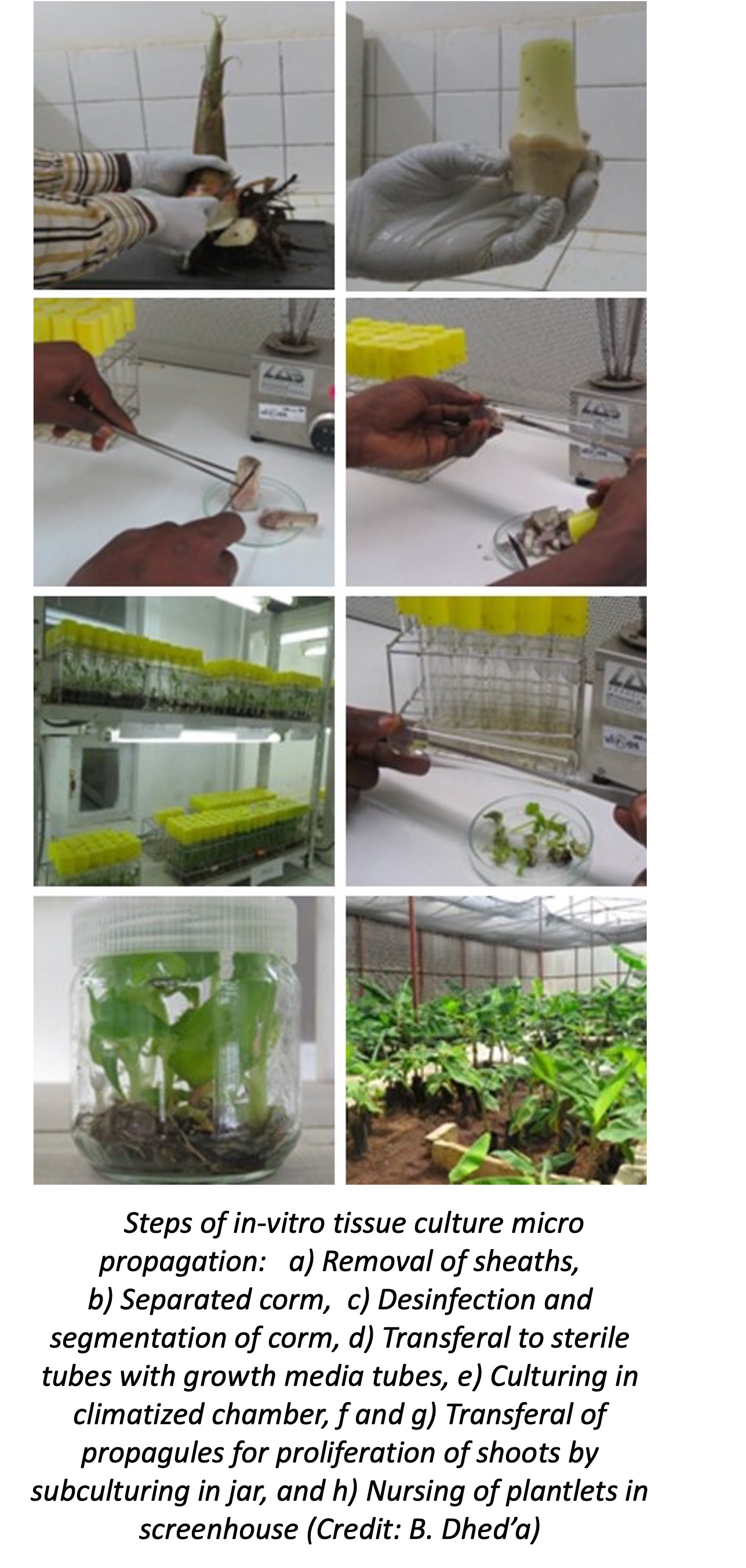In-Vitro Tissue Culture Propagation
Résumé
Banana and plantain is propagated in the laboratory through tissue culture (TC). In vitro micro-propagation eliminates all pests and diseases except for viruses. TC consists of five important steps: initiation, multiplication, shooting and rooting, primary hardening in green houses and secondary hardening in shade houses. TC plants have the benefits of uniformity and fast propagation of large numbers of plantlets. These advantages enable marketing and more rapid recovery from broad-scale damage such as disease outbreak and extreme weather.
En savoir plus sur la solution
In-vitro micro-propagation relies upon a liquid, semi-solid, or solid growth medium such as broth or agar multiplied under sterile growing conditions. The most common tissue culture techniques is meristem culture but other techniques such as callus culture, somatic embryogenesis, cell suspension, and protoplast culture are possible. TC plantlets tend to be less robust than suckers and require greater care due to their initial sterile production devoid of beneficial microorganisms. They are nevertheless regularly planted into fields with high pest and disease burdens and abiotic constraints. Inoculation of TC plantlets with beneficial microorganisms such as Fusarium oxysporum and Trichoderma spp. helps to reintroduce immunity. Micro-propagation through tissue culture techniques is an efficient method of producing large quantities and good quality plantlets but requires high capital investment and skills. Strict adherence to aseptic standards and micro-climatic conditions and care during the hardening is important. Careful examination of the stock is required to avoid culturing the infected plants. Farmers should be aware that planting TC culture plantlets from a single banana or plantain species causes low genetic diversity and variability that poses a risk if disease or pest outbreak occurs.
Tissue-cultured banana seedlings are not always conveniently available. Larger-scale banana farmers may wish to establish their own banana tissue-culture facility to ensure availability of disease-free seedlings. To make TC plantlets readily accessible to farmers in remote areas, there is need for linkages with macro-propagation nurseries.
Water purification systems for producing double distilled water are needed to prepare the stock solutions and media, autoclave for sterilizing tools and media, pH meter and refrigerator to store the stock solutions and hormones. Laminar airflow cabinets to perform culturing and subculturing plants, these can be high-end models for specialized laboratories with large output capacity but may also be fabricated with plastic boxes and a small air filter. Other materials required include a pH meter, hot plate/stirrer, glasswares and beakers, forceps, bunsen burner, wash bottles, brushes, culture vessels and tubes, Erlenmeyer flasks, graduated cylinders, glass pipettes, scalpel handles, and blades, spatulas, stir bars, roll tape, gloves, parafilm, lab markers, paper towels, detergents, isopropyl alcohol, chlorine bleach, and brushes. Growth media for the preculture are made with Murashige & Skoog basal medium supplemented with 5.0 mg/l BAP, and subculture media are half of those concentrations. An air-conditioned room fitted with two 40-watt fluorescent tubes and a 16-hour photoperiod.
The first step is to collect suckers 40–100 cm tall from strong mother plants that are free of disease symptoms, making sure to separate the sucker without cracking the corm. It is advised to collect at least two suckers from each plant source, one for micropropagation and the other for a nursery farm for future propagation. Approximately 10 cm of inner tissue containing the meristematic corm is excised from the stem by removing the leaf sheaths in a clean laboratory and rinsed with water to wash of soil. The second part of the process happens in a laminary flow hood using autoclaved scalpels, forceps, cutting plates and solutions. The entire corm is disinfected by submerging it in series of disinfectant solutions. Next, the surface-sterilized corm is trimmed until it measures 1 × 1 cm, with the corm tissue as thin as possible. On a fresh cutting plate, the corm is cut longitudinally into propagules of 0.5 cm. Propagules are placed in tubes with growth media and closed with an open cap. Over one month the propagules are kept in the room during which bulging and browning of the corm, greening of leaf tissue and shoot emergence is monitored. Contaminated or off-growth precultures must be discarded. When the propagules are 2 cm tall, they are transferred from tubes into jars with growth media to proliferate more shoots. Larger propagules can be cut in two. These subcultures must be kept in the growth chamber for 3-4 weeks to obtain desired numbers of shoots.
Commercialisation
Disponible dans le commerce
Images de la Solution
Institutions


